Zara's Fast Fashion: An Analysis of Business Ethics and Sustainability
VerifiedAdded on 2022/01/02
|12
|3464
|44
Report
AI Summary
This report provides a comprehensive analysis of Zara's fast fashion business model, focusing on its ethical and sustainability implications. The report begins with an introduction to the case study, highlighting the environmental challenges arising from Zara's operations, particularly concerning global warming. It then delves into a detailed overview of Zara's supply chain, emphasizing its efficiency in delivering new products but also its detrimental impact on the environment. The report offers several recommendations, including evaluating environmental impact, implementing corporate social responsibility (CSR) models, adopting sustainability supply chain management (SSCM), utilizing clean energy sources, and using greener products. Strategic and operational dimensions are also discussed, emphasizing the need for aligning business strategies with ethical and sustainable policies. The report concludes by identifying opportunities and challenges within the retailing industry regarding ethics and sustainability.
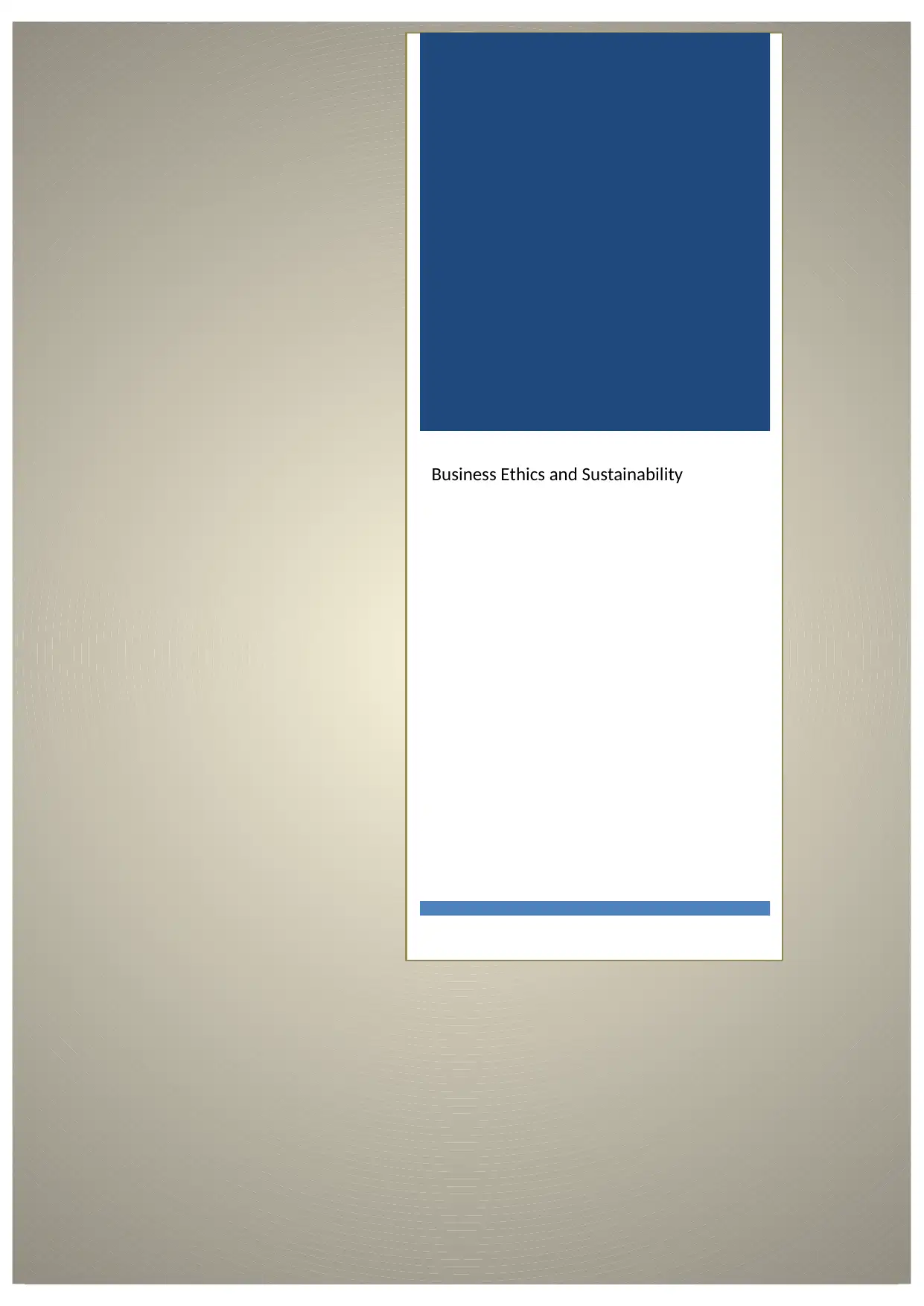
Business Ethics and Sustainability
Paraphrase This Document
Need a fresh take? Get an instant paraphrase of this document with our AI Paraphraser
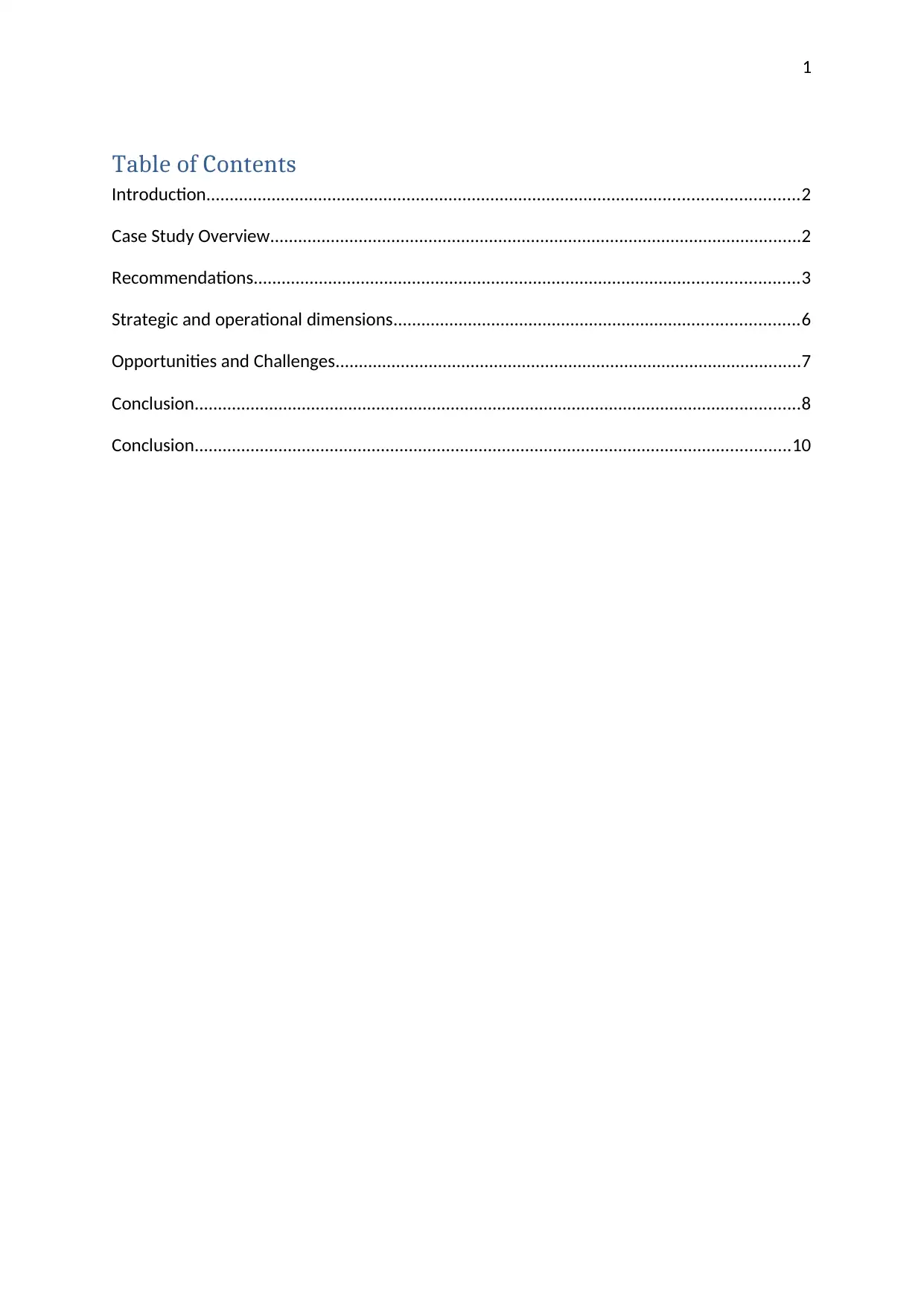
1
Table of Contents
Introduction...............................................................................................................................2
Case Study Overview..................................................................................................................2
Recommendations.....................................................................................................................3
Strategic and operational dimensions.......................................................................................6
Opportunities and Challenges....................................................................................................7
Conclusion..................................................................................................................................8
Conclusion................................................................................................................................10
Table of Contents
Introduction...............................................................................................................................2
Case Study Overview..................................................................................................................2
Recommendations.....................................................................................................................3
Strategic and operational dimensions.......................................................................................6
Opportunities and Challenges....................................................................................................7
Conclusion..................................................................................................................................8
Conclusion................................................................................................................................10

2
Introduction
In this report, the case study titled ‘Zara: Fast Fashion’ will be evaluated in order to
understand the key issues arise in the case relating to global warming. This report will
analyse how the operations and processes of Zara have failed to consider their impact on
the environment which results in created challenges for everyone. Various
recommendations will be given in this report which can assist in addressing the ethical and
sustainability issues raised in this case of Zara while considering their implications for
governments, producers and consumers. Lastly, the challenges and opportunities which are
inherent in the recommendations relating to ethics and sustainability will be identified
within the retailing industry.
Case Study Overview
In the case study of ‘Zara: Fast Fashion’, details regarding the operations of Zara are given
which assist Inditex (the parent company of Zara) in becoming a key player in the fast
fashion retailing market. The corporation offers its products and services in 96 offline
markets and 46 online markets. Inditex has generated a competitive advantage in the fast
fashion based on its responsive supply chain which enables the corporations to offer new
and designer products to its customers every week. The supply chain assists the corporation
in changing more than 75 percent of its merchandise display in its stores situated across the
globe within a period of 3 to 4 weeks (Corfton and Dopico, 2012). The key competitors of
Zara include GAP, H&M and MANGO. The supply chain of these competitors is not efficient
enough to ensure that they are able to change their offering within a period of 3 to 4 weeks.
Companies such as GAP take around 6 months to change its entire offerings due to which
they are unable to provide competition to Zara. Zara is able to achieve efficiency in its
supply chain because it uses both in-house and outsources manufacturing process to
manufacture its products (de Jorge Moreno and Carrasco, 2016).
The corporation produces around 50 percent of its products through the in-house
manufacturing process. The corporation outsources 26 percent of its manufacturing process
to countries in Europe and 24 percent to Asian countries (Corfton and Dopico, 2012). Due to
Introduction
In this report, the case study titled ‘Zara: Fast Fashion’ will be evaluated in order to
understand the key issues arise in the case relating to global warming. This report will
analyse how the operations and processes of Zara have failed to consider their impact on
the environment which results in created challenges for everyone. Various
recommendations will be given in this report which can assist in addressing the ethical and
sustainability issues raised in this case of Zara while considering their implications for
governments, producers and consumers. Lastly, the challenges and opportunities which are
inherent in the recommendations relating to ethics and sustainability will be identified
within the retailing industry.
Case Study Overview
In the case study of ‘Zara: Fast Fashion’, details regarding the operations of Zara are given
which assist Inditex (the parent company of Zara) in becoming a key player in the fast
fashion retailing market. The corporation offers its products and services in 96 offline
markets and 46 online markets. Inditex has generated a competitive advantage in the fast
fashion based on its responsive supply chain which enables the corporations to offer new
and designer products to its customers every week. The supply chain assists the corporation
in changing more than 75 percent of its merchandise display in its stores situated across the
globe within a period of 3 to 4 weeks (Corfton and Dopico, 2012). The key competitors of
Zara include GAP, H&M and MANGO. The supply chain of these competitors is not efficient
enough to ensure that they are able to change their offering within a period of 3 to 4 weeks.
Companies such as GAP take around 6 months to change its entire offerings due to which
they are unable to provide competition to Zara. Zara is able to achieve efficiency in its
supply chain because it uses both in-house and outsources manufacturing process to
manufacture its products (de Jorge Moreno and Carrasco, 2016).
The corporation produces around 50 percent of its products through the in-house
manufacturing process. The corporation outsources 26 percent of its manufacturing process
to countries in Europe and 24 percent to Asian countries (Corfton and Dopico, 2012). Due to
⊘ This is a preview!⊘
Do you want full access?
Subscribe today to unlock all pages.

Trusted by 1+ million students worldwide
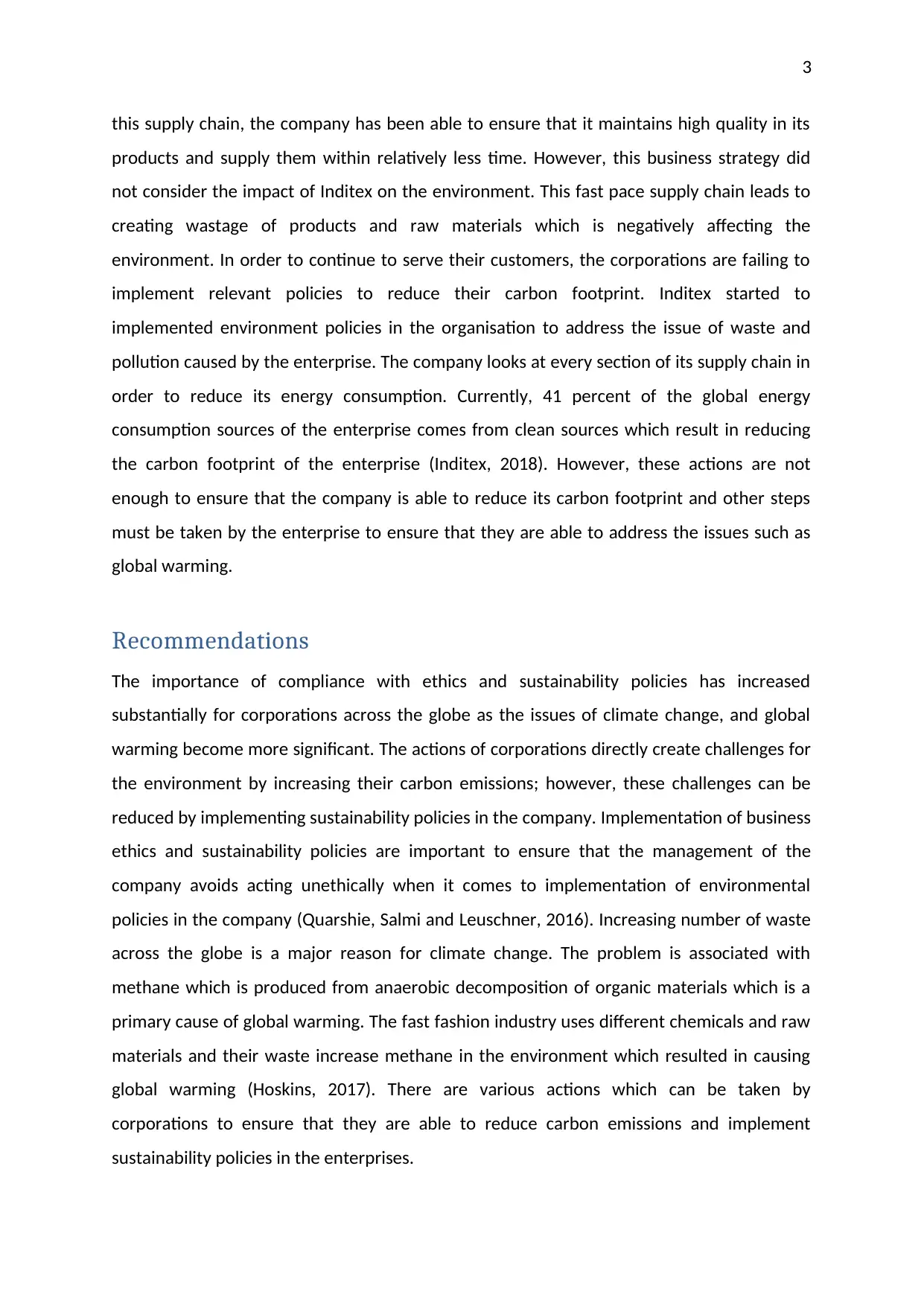
3
this supply chain, the company has been able to ensure that it maintains high quality in its
products and supply them within relatively less time. However, this business strategy did
not consider the impact of Inditex on the environment. This fast pace supply chain leads to
creating wastage of products and raw materials which is negatively affecting the
environment. In order to continue to serve their customers, the corporations are failing to
implement relevant policies to reduce their carbon footprint. Inditex started to
implemented environment policies in the organisation to address the issue of waste and
pollution caused by the enterprise. The company looks at every section of its supply chain in
order to reduce its energy consumption. Currently, 41 percent of the global energy
consumption sources of the enterprise comes from clean sources which result in reducing
the carbon footprint of the enterprise (Inditex, 2018). However, these actions are not
enough to ensure that the company is able to reduce its carbon footprint and other steps
must be taken by the enterprise to ensure that they are able to address the issues such as
global warming.
Recommendations
The importance of compliance with ethics and sustainability policies has increased
substantially for corporations across the globe as the issues of climate change, and global
warming become more significant. The actions of corporations directly create challenges for
the environment by increasing their carbon emissions; however, these challenges can be
reduced by implementing sustainability policies in the company. Implementation of business
ethics and sustainability policies are important to ensure that the management of the
company avoids acting unethically when it comes to implementation of environmental
policies in the company (Quarshie, Salmi and Leuschner, 2016). Increasing number of waste
across the globe is a major reason for climate change. The problem is associated with
methane which is produced from anaerobic decomposition of organic materials which is a
primary cause of global warming. The fast fashion industry uses different chemicals and raw
materials and their waste increase methane in the environment which resulted in causing
global warming (Hoskins, 2017). There are various actions which can be taken by
corporations to ensure that they are able to reduce carbon emissions and implement
sustainability policies in the enterprises.
this supply chain, the company has been able to ensure that it maintains high quality in its
products and supply them within relatively less time. However, this business strategy did
not consider the impact of Inditex on the environment. This fast pace supply chain leads to
creating wastage of products and raw materials which is negatively affecting the
environment. In order to continue to serve their customers, the corporations are failing to
implement relevant policies to reduce their carbon footprint. Inditex started to
implemented environment policies in the organisation to address the issue of waste and
pollution caused by the enterprise. The company looks at every section of its supply chain in
order to reduce its energy consumption. Currently, 41 percent of the global energy
consumption sources of the enterprise comes from clean sources which result in reducing
the carbon footprint of the enterprise (Inditex, 2018). However, these actions are not
enough to ensure that the company is able to reduce its carbon footprint and other steps
must be taken by the enterprise to ensure that they are able to address the issues such as
global warming.
Recommendations
The importance of compliance with ethics and sustainability policies has increased
substantially for corporations across the globe as the issues of climate change, and global
warming become more significant. The actions of corporations directly create challenges for
the environment by increasing their carbon emissions; however, these challenges can be
reduced by implementing sustainability policies in the company. Implementation of business
ethics and sustainability policies are important to ensure that the management of the
company avoids acting unethically when it comes to implementation of environmental
policies in the company (Quarshie, Salmi and Leuschner, 2016). Increasing number of waste
across the globe is a major reason for climate change. The problem is associated with
methane which is produced from anaerobic decomposition of organic materials which is a
primary cause of global warming. The fast fashion industry uses different chemicals and raw
materials and their waste increase methane in the environment which resulted in causing
global warming (Hoskins, 2017). There are various actions which can be taken by
corporations to ensure that they are able to reduce carbon emissions and implement
sustainability policies in the enterprises.
Paraphrase This Document
Need a fresh take? Get an instant paraphrase of this document with our AI Paraphraser
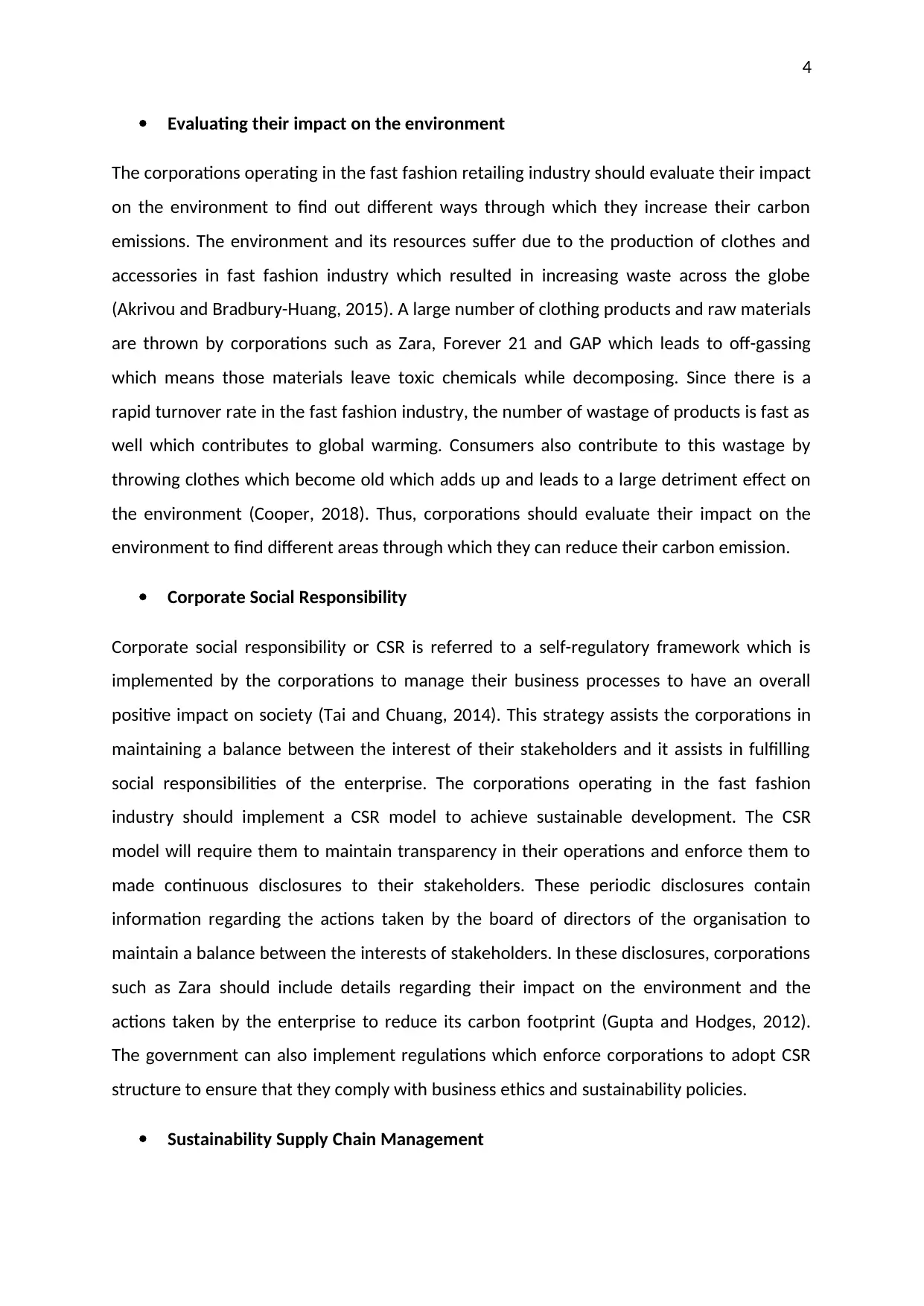
4
Evaluating their impact on the environment
The corporations operating in the fast fashion retailing industry should evaluate their impact
on the environment to find out different ways through which they increase their carbon
emissions. The environment and its resources suffer due to the production of clothes and
accessories in fast fashion industry which resulted in increasing waste across the globe
(Akrivou and Bradbury-Huang, 2015). A large number of clothing products and raw materials
are thrown by corporations such as Zara, Forever 21 and GAP which leads to off-gassing
which means those materials leave toxic chemicals while decomposing. Since there is a
rapid turnover rate in the fast fashion industry, the number of wastage of products is fast as
well which contributes to global warming. Consumers also contribute to this wastage by
throwing clothes which become old which adds up and leads to a large detriment effect on
the environment (Cooper, 2018). Thus, corporations should evaluate their impact on the
environment to find different areas through which they can reduce their carbon emission.
Corporate Social Responsibility
Corporate social responsibility or CSR is referred to a self-regulatory framework which is
implemented by the corporations to manage their business processes to have an overall
positive impact on society (Tai and Chuang, 2014). This strategy assists the corporations in
maintaining a balance between the interest of their stakeholders and it assists in fulfilling
social responsibilities of the enterprise. The corporations operating in the fast fashion
industry should implement a CSR model to achieve sustainable development. The CSR
model will require them to maintain transparency in their operations and enforce them to
made continuous disclosures to their stakeholders. These periodic disclosures contain
information regarding the actions taken by the board of directors of the organisation to
maintain a balance between the interests of stakeholders. In these disclosures, corporations
such as Zara should include details regarding their impact on the environment and the
actions taken by the enterprise to reduce its carbon footprint (Gupta and Hodges, 2012).
The government can also implement regulations which enforce corporations to adopt CSR
structure to ensure that they comply with business ethics and sustainability policies.
Sustainability Supply Chain Management
Evaluating their impact on the environment
The corporations operating in the fast fashion retailing industry should evaluate their impact
on the environment to find out different ways through which they increase their carbon
emissions. The environment and its resources suffer due to the production of clothes and
accessories in fast fashion industry which resulted in increasing waste across the globe
(Akrivou and Bradbury-Huang, 2015). A large number of clothing products and raw materials
are thrown by corporations such as Zara, Forever 21 and GAP which leads to off-gassing
which means those materials leave toxic chemicals while decomposing. Since there is a
rapid turnover rate in the fast fashion industry, the number of wastage of products is fast as
well which contributes to global warming. Consumers also contribute to this wastage by
throwing clothes which become old which adds up and leads to a large detriment effect on
the environment (Cooper, 2018). Thus, corporations should evaluate their impact on the
environment to find different areas through which they can reduce their carbon emission.
Corporate Social Responsibility
Corporate social responsibility or CSR is referred to a self-regulatory framework which is
implemented by the corporations to manage their business processes to have an overall
positive impact on society (Tai and Chuang, 2014). This strategy assists the corporations in
maintaining a balance between the interest of their stakeholders and it assists in fulfilling
social responsibilities of the enterprise. The corporations operating in the fast fashion
industry should implement a CSR model to achieve sustainable development. The CSR
model will require them to maintain transparency in their operations and enforce them to
made continuous disclosures to their stakeholders. These periodic disclosures contain
information regarding the actions taken by the board of directors of the organisation to
maintain a balance between the interests of stakeholders. In these disclosures, corporations
such as Zara should include details regarding their impact on the environment and the
actions taken by the enterprise to reduce its carbon footprint (Gupta and Hodges, 2012).
The government can also implement regulations which enforce corporations to adopt CSR
structure to ensure that they comply with business ethics and sustainability policies.
Sustainability Supply Chain Management
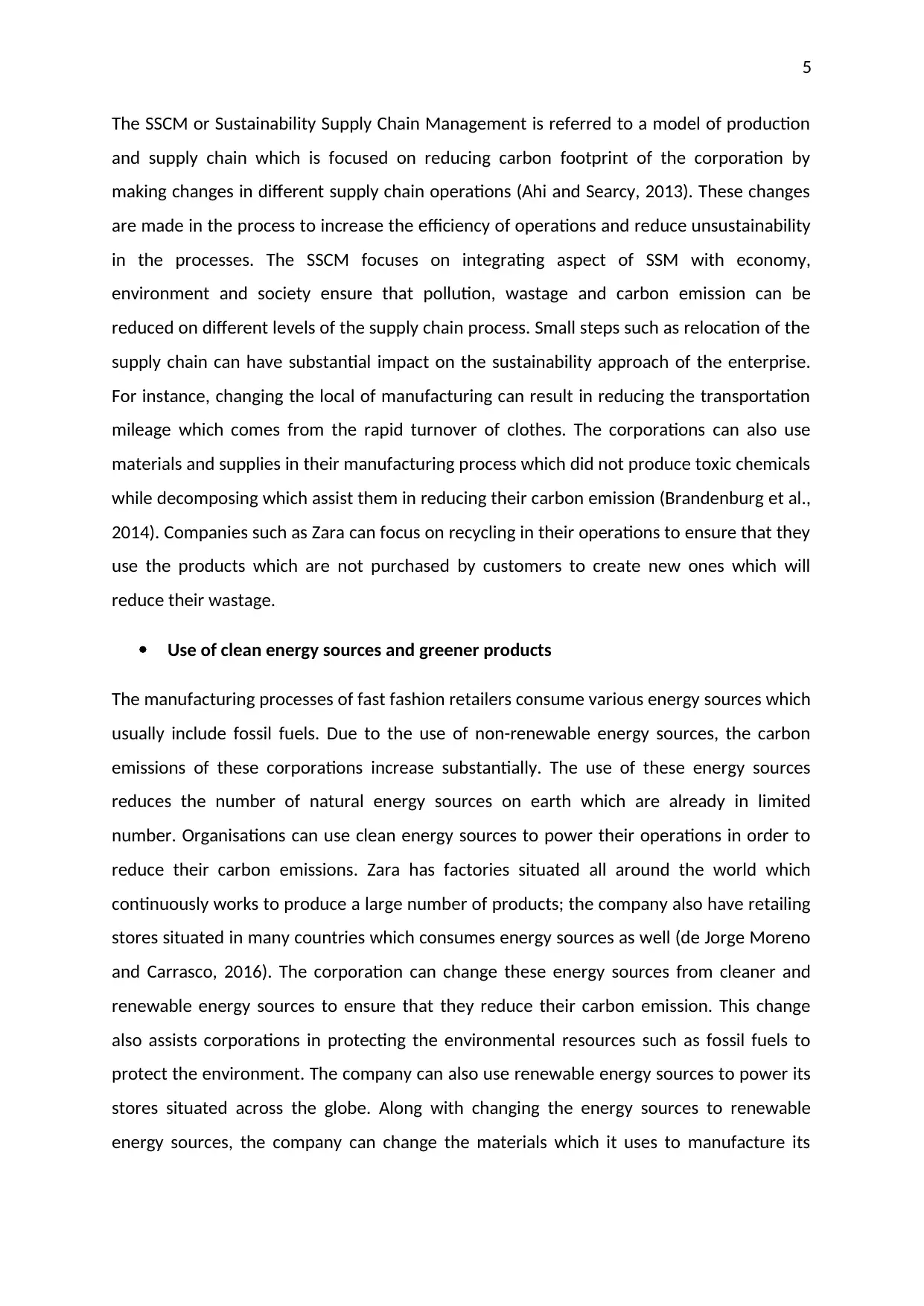
5
The SSCM or Sustainability Supply Chain Management is referred to a model of production
and supply chain which is focused on reducing carbon footprint of the corporation by
making changes in different supply chain operations (Ahi and Searcy, 2013). These changes
are made in the process to increase the efficiency of operations and reduce unsustainability
in the processes. The SSCM focuses on integrating aspect of SSM with economy,
environment and society ensure that pollution, wastage and carbon emission can be
reduced on different levels of the supply chain process. Small steps such as relocation of the
supply chain can have substantial impact on the sustainability approach of the enterprise.
For instance, changing the local of manufacturing can result in reducing the transportation
mileage which comes from the rapid turnover of clothes. The corporations can also use
materials and supplies in their manufacturing process which did not produce toxic chemicals
while decomposing which assist them in reducing their carbon emission (Brandenburg et al.,
2014). Companies such as Zara can focus on recycling in their operations to ensure that they
use the products which are not purchased by customers to create new ones which will
reduce their wastage.
Use of clean energy sources and greener products
The manufacturing processes of fast fashion retailers consume various energy sources which
usually include fossil fuels. Due to the use of non-renewable energy sources, the carbon
emissions of these corporations increase substantially. The use of these energy sources
reduces the number of natural energy sources on earth which are already in limited
number. Organisations can use clean energy sources to power their operations in order to
reduce their carbon emissions. Zara has factories situated all around the world which
continuously works to produce a large number of products; the company also have retailing
stores situated in many countries which consumes energy sources as well (de Jorge Moreno
and Carrasco, 2016). The corporation can change these energy sources from cleaner and
renewable energy sources to ensure that they reduce their carbon emission. This change
also assists corporations in protecting the environmental resources such as fossil fuels to
protect the environment. The company can also use renewable energy sources to power its
stores situated across the globe. Along with changing the energy sources to renewable
energy sources, the company can change the materials which it uses to manufacture its
The SSCM or Sustainability Supply Chain Management is referred to a model of production
and supply chain which is focused on reducing carbon footprint of the corporation by
making changes in different supply chain operations (Ahi and Searcy, 2013). These changes
are made in the process to increase the efficiency of operations and reduce unsustainability
in the processes. The SSCM focuses on integrating aspect of SSM with economy,
environment and society ensure that pollution, wastage and carbon emission can be
reduced on different levels of the supply chain process. Small steps such as relocation of the
supply chain can have substantial impact on the sustainability approach of the enterprise.
For instance, changing the local of manufacturing can result in reducing the transportation
mileage which comes from the rapid turnover of clothes. The corporations can also use
materials and supplies in their manufacturing process which did not produce toxic chemicals
while decomposing which assist them in reducing their carbon emission (Brandenburg et al.,
2014). Companies such as Zara can focus on recycling in their operations to ensure that they
use the products which are not purchased by customers to create new ones which will
reduce their wastage.
Use of clean energy sources and greener products
The manufacturing processes of fast fashion retailers consume various energy sources which
usually include fossil fuels. Due to the use of non-renewable energy sources, the carbon
emissions of these corporations increase substantially. The use of these energy sources
reduces the number of natural energy sources on earth which are already in limited
number. Organisations can use clean energy sources to power their operations in order to
reduce their carbon emissions. Zara has factories situated all around the world which
continuously works to produce a large number of products; the company also have retailing
stores situated in many countries which consumes energy sources as well (de Jorge Moreno
and Carrasco, 2016). The corporation can change these energy sources from cleaner and
renewable energy sources to ensure that they reduce their carbon emission. This change
also assists corporations in protecting the environmental resources such as fossil fuels to
protect the environment. The company can also use renewable energy sources to power its
stores situated across the globe. Along with changing the energy sources to renewable
energy sources, the company can change the materials which it uses to manufacture its
⊘ This is a preview!⊘
Do you want full access?
Subscribe today to unlock all pages.

Trusted by 1+ million students worldwide

6
products. Zara can use recycled materials and alternative greener options in order to
improve the sustainability of its supply chain.
Strategic and operational dimensions
While implementing a sustainable and ethical approach in the organisation, there are
various strategic and operations dimensions which corporations have to consider. In order
to reduce global warming and its impact on the world, large enterprises should take
initiatives to reduce their carbon emissions. The board of directors of the corporations
should engage in the strategic procedure to find different sources through implementing
business strategies in order to ensure that they are able to link the business strategy along
with ethical and sustainable policies (Corfton and Dopico, 2012). Zara should implement
strategic policies to incorporate the above mention recommendations in its business
strategy to ensure that it implements a sustainable approach. The board of directors of the
corporation should change the mission and vision of the organisation to align it with ethical
and sustainability goals. The vision of the company should reflect regarding how it is focused
on maintaining a balance between different stakeholders of the enterprise. The mission of
the company should also ensure that it is responsible for different stakeholders of the
enterprise.
Implementing the strategic policies are not enough, and the corporation is required to
continuously monitor these policies to oversee their implementation. Continuous reporting
is necessary to ensure that the strategic policies which are implemented by the corporation
are followed in different operations such as production, manufacturing and others (Orcao
and Perez, 2014). In the case of fast fashion retailers, they can achieve sustainability by
ensuring that evaluate their operations and find different areas where they can improve to
adopt a sustainable approach in the business. The corporation can also change their
suppliers to find new ones that produce and manufacture products ethically. A good
example is the cotton industry in Australia which is mostly operating by families. Australia is
a major cotton producer country which provides employment to many companies, and they
conduct their operations in ethical manner while contributing to sustainable development
of the nation (Cotton Australia, 2018). Zara should purchase products from these ethical
products. Zara can use recycled materials and alternative greener options in order to
improve the sustainability of its supply chain.
Strategic and operational dimensions
While implementing a sustainable and ethical approach in the organisation, there are
various strategic and operations dimensions which corporations have to consider. In order
to reduce global warming and its impact on the world, large enterprises should take
initiatives to reduce their carbon emissions. The board of directors of the corporations
should engage in the strategic procedure to find different sources through implementing
business strategies in order to ensure that they are able to link the business strategy along
with ethical and sustainable policies (Corfton and Dopico, 2012). Zara should implement
strategic policies to incorporate the above mention recommendations in its business
strategy to ensure that it implements a sustainable approach. The board of directors of the
corporation should change the mission and vision of the organisation to align it with ethical
and sustainability goals. The vision of the company should reflect regarding how it is focused
on maintaining a balance between different stakeholders of the enterprise. The mission of
the company should also ensure that it is responsible for different stakeholders of the
enterprise.
Implementing the strategic policies are not enough, and the corporation is required to
continuously monitor these policies to oversee their implementation. Continuous reporting
is necessary to ensure that the strategic policies which are implemented by the corporation
are followed in different operations such as production, manufacturing and others (Orcao
and Perez, 2014). In the case of fast fashion retailers, they can achieve sustainability by
ensuring that evaluate their operations and find different areas where they can improve to
adopt a sustainable approach in the business. The corporation can also change their
suppliers to find new ones that produce and manufacture products ethically. A good
example is the cotton industry in Australia which is mostly operating by families. Australia is
a major cotton producer country which provides employment to many companies, and they
conduct their operations in ethical manner while contributing to sustainable development
of the nation (Cotton Australia, 2018). Zara should purchase products from these ethical
Paraphrase This Document
Need a fresh take? Get an instant paraphrase of this document with our AI Paraphraser
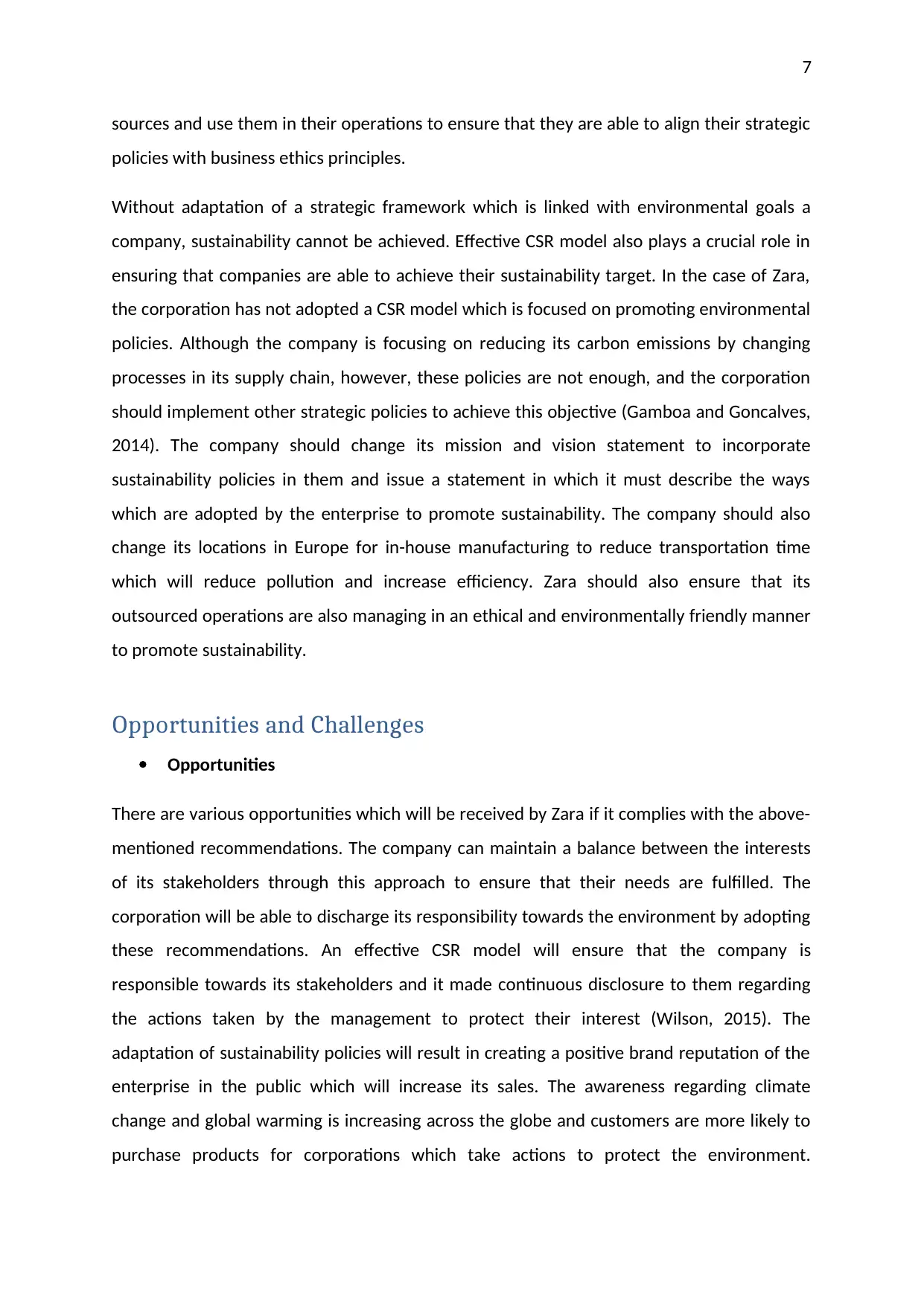
7
sources and use them in their operations to ensure that they are able to align their strategic
policies with business ethics principles.
Without adaptation of a strategic framework which is linked with environmental goals a
company, sustainability cannot be achieved. Effective CSR model also plays a crucial role in
ensuring that companies are able to achieve their sustainability target. In the case of Zara,
the corporation has not adopted a CSR model which is focused on promoting environmental
policies. Although the company is focusing on reducing its carbon emissions by changing
processes in its supply chain, however, these policies are not enough, and the corporation
should implement other strategic policies to achieve this objective (Gamboa and Goncalves,
2014). The company should change its mission and vision statement to incorporate
sustainability policies in them and issue a statement in which it must describe the ways
which are adopted by the enterprise to promote sustainability. The company should also
change its locations in Europe for in-house manufacturing to reduce transportation time
which will reduce pollution and increase efficiency. Zara should also ensure that its
outsourced operations are also managing in an ethical and environmentally friendly manner
to promote sustainability.
Opportunities and Challenges
Opportunities
There are various opportunities which will be received by Zara if it complies with the above-
mentioned recommendations. The company can maintain a balance between the interests
of its stakeholders through this approach to ensure that their needs are fulfilled. The
corporation will be able to discharge its responsibility towards the environment by adopting
these recommendations. An effective CSR model will ensure that the company is
responsible towards its stakeholders and it made continuous disclosure to them regarding
the actions taken by the management to protect their interest (Wilson, 2015). The
adaptation of sustainability policies will result in creating a positive brand reputation of the
enterprise in the public which will increase its sales. The awareness regarding climate
change and global warming is increasing across the globe and customers are more likely to
purchase products for corporations which take actions to protect the environment.
sources and use them in their operations to ensure that they are able to align their strategic
policies with business ethics principles.
Without adaptation of a strategic framework which is linked with environmental goals a
company, sustainability cannot be achieved. Effective CSR model also plays a crucial role in
ensuring that companies are able to achieve their sustainability target. In the case of Zara,
the corporation has not adopted a CSR model which is focused on promoting environmental
policies. Although the company is focusing on reducing its carbon emissions by changing
processes in its supply chain, however, these policies are not enough, and the corporation
should implement other strategic policies to achieve this objective (Gamboa and Goncalves,
2014). The company should change its mission and vision statement to incorporate
sustainability policies in them and issue a statement in which it must describe the ways
which are adopted by the enterprise to promote sustainability. The company should also
change its locations in Europe for in-house manufacturing to reduce transportation time
which will reduce pollution and increase efficiency. Zara should also ensure that its
outsourced operations are also managing in an ethical and environmentally friendly manner
to promote sustainability.
Opportunities and Challenges
Opportunities
There are various opportunities which will be received by Zara if it complies with the above-
mentioned recommendations. The company can maintain a balance between the interests
of its stakeholders through this approach to ensure that their needs are fulfilled. The
corporation will be able to discharge its responsibility towards the environment by adopting
these recommendations. An effective CSR model will ensure that the company is
responsible towards its stakeholders and it made continuous disclosure to them regarding
the actions taken by the management to protect their interest (Wilson, 2015). The
adaptation of sustainability policies will result in creating a positive brand reputation of the
enterprise in the public which will increase its sales. The awareness regarding climate
change and global warming is increasing across the globe and customers are more likely to
purchase products for corporations which take actions to protect the environment.
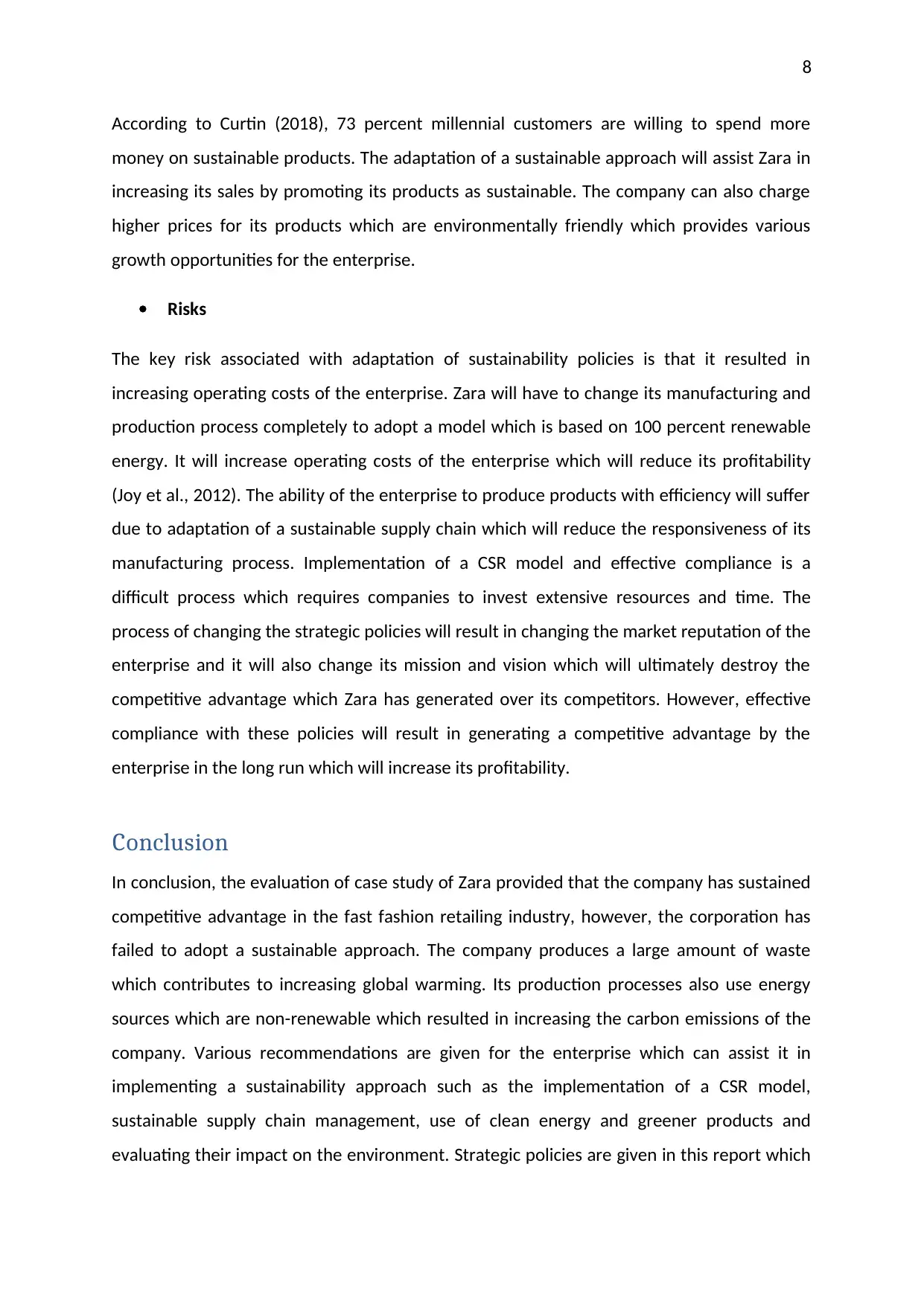
8
According to Curtin (2018), 73 percent millennial customers are willing to spend more
money on sustainable products. The adaptation of a sustainable approach will assist Zara in
increasing its sales by promoting its products as sustainable. The company can also charge
higher prices for its products which are environmentally friendly which provides various
growth opportunities for the enterprise.
Risks
The key risk associated with adaptation of sustainability policies is that it resulted in
increasing operating costs of the enterprise. Zara will have to change its manufacturing and
production process completely to adopt a model which is based on 100 percent renewable
energy. It will increase operating costs of the enterprise which will reduce its profitability
(Joy et al., 2012). The ability of the enterprise to produce products with efficiency will suffer
due to adaptation of a sustainable supply chain which will reduce the responsiveness of its
manufacturing process. Implementation of a CSR model and effective compliance is a
difficult process which requires companies to invest extensive resources and time. The
process of changing the strategic policies will result in changing the market reputation of the
enterprise and it will also change its mission and vision which will ultimately destroy the
competitive advantage which Zara has generated over its competitors. However, effective
compliance with these policies will result in generating a competitive advantage by the
enterprise in the long run which will increase its profitability.
Conclusion
In conclusion, the evaluation of case study of Zara provided that the company has sustained
competitive advantage in the fast fashion retailing industry, however, the corporation has
failed to adopt a sustainable approach. The company produces a large amount of waste
which contributes to increasing global warming. Its production processes also use energy
sources which are non-renewable which resulted in increasing the carbon emissions of the
company. Various recommendations are given for the enterprise which can assist it in
implementing a sustainability approach such as the implementation of a CSR model,
sustainable supply chain management, use of clean energy and greener products and
evaluating their impact on the environment. Strategic policies are given in this report which
According to Curtin (2018), 73 percent millennial customers are willing to spend more
money on sustainable products. The adaptation of a sustainable approach will assist Zara in
increasing its sales by promoting its products as sustainable. The company can also charge
higher prices for its products which are environmentally friendly which provides various
growth opportunities for the enterprise.
Risks
The key risk associated with adaptation of sustainability policies is that it resulted in
increasing operating costs of the enterprise. Zara will have to change its manufacturing and
production process completely to adopt a model which is based on 100 percent renewable
energy. It will increase operating costs of the enterprise which will reduce its profitability
(Joy et al., 2012). The ability of the enterprise to produce products with efficiency will suffer
due to adaptation of a sustainable supply chain which will reduce the responsiveness of its
manufacturing process. Implementation of a CSR model and effective compliance is a
difficult process which requires companies to invest extensive resources and time. The
process of changing the strategic policies will result in changing the market reputation of the
enterprise and it will also change its mission and vision which will ultimately destroy the
competitive advantage which Zara has generated over its competitors. However, effective
compliance with these policies will result in generating a competitive advantage by the
enterprise in the long run which will increase its profitability.
Conclusion
In conclusion, the evaluation of case study of Zara provided that the company has sustained
competitive advantage in the fast fashion retailing industry, however, the corporation has
failed to adopt a sustainable approach. The company produces a large amount of waste
which contributes to increasing global warming. Its production processes also use energy
sources which are non-renewable which resulted in increasing the carbon emissions of the
company. Various recommendations are given for the enterprise which can assist it in
implementing a sustainability approach such as the implementation of a CSR model,
sustainable supply chain management, use of clean energy and greener products and
evaluating their impact on the environment. Strategic policies are given in this report which
⊘ This is a preview!⊘
Do you want full access?
Subscribe today to unlock all pages.

Trusted by 1+ million students worldwide
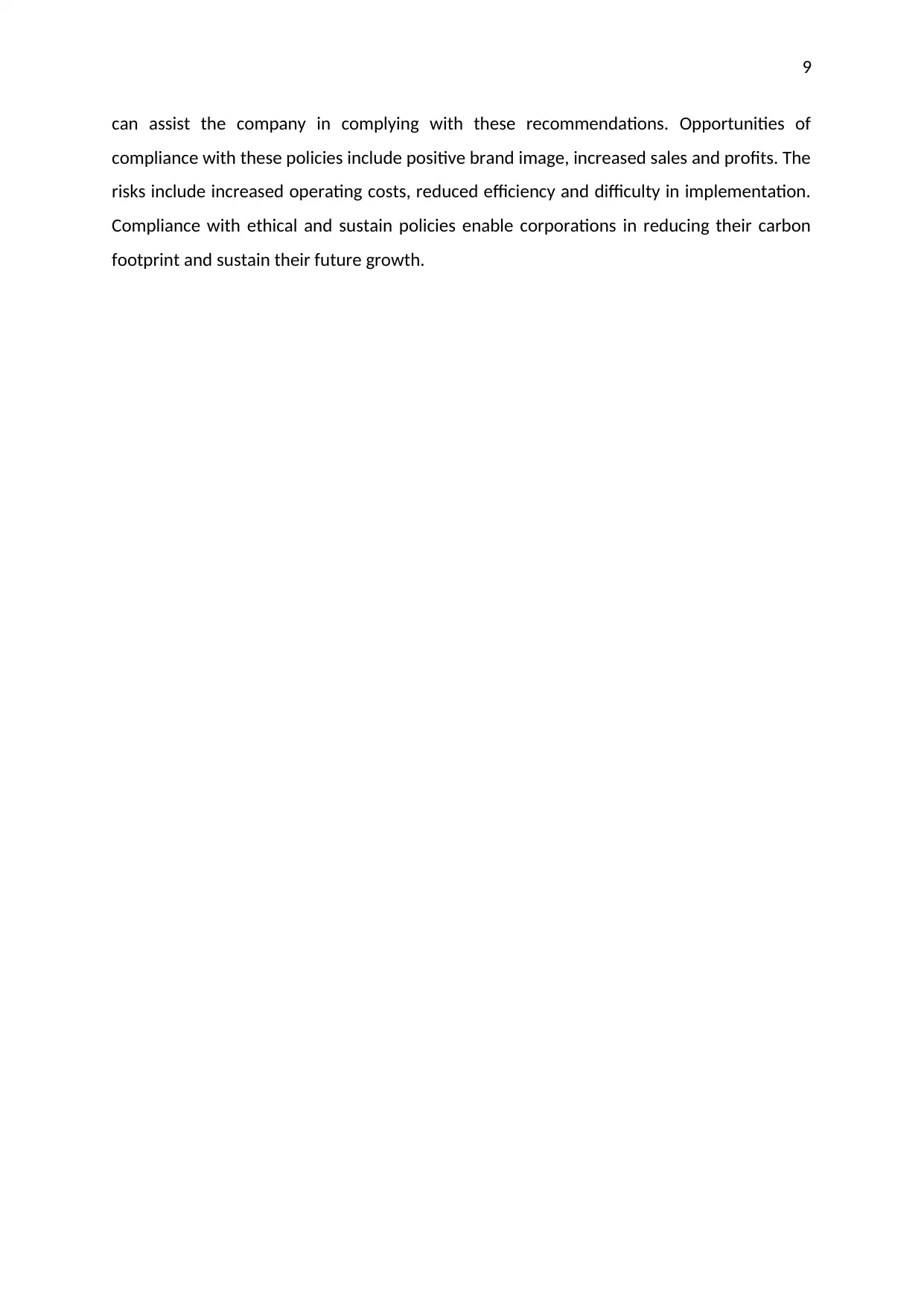
9
can assist the company in complying with these recommendations. Opportunities of
compliance with these policies include positive brand image, increased sales and profits. The
risks include increased operating costs, reduced efficiency and difficulty in implementation.
Compliance with ethical and sustain policies enable corporations in reducing their carbon
footprint and sustain their future growth.
can assist the company in complying with these recommendations. Opportunities of
compliance with these policies include positive brand image, increased sales and profits. The
risks include increased operating costs, reduced efficiency and difficulty in implementation.
Compliance with ethical and sustain policies enable corporations in reducing their carbon
footprint and sustain their future growth.
Paraphrase This Document
Need a fresh take? Get an instant paraphrase of this document with our AI Paraphraser
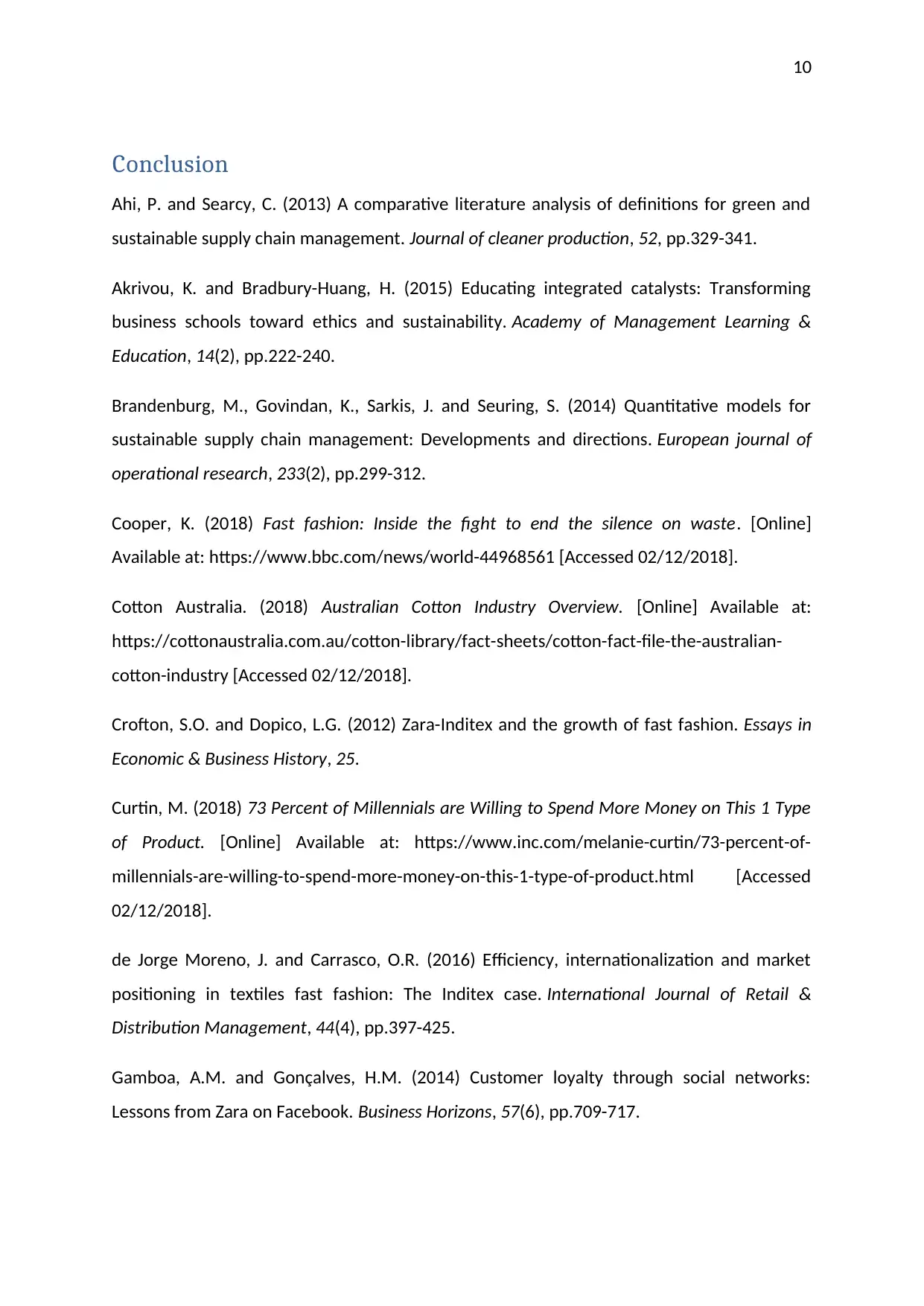
10
Conclusion
Ahi, P. and Searcy, C. (2013) A comparative literature analysis of definitions for green and
sustainable supply chain management. Journal of cleaner production, 52, pp.329-341.
Akrivou, K. and Bradbury-Huang, H. (2015) Educating integrated catalysts: Transforming
business schools toward ethics and sustainability. Academy of Management Learning &
Education, 14(2), pp.222-240.
Brandenburg, M., Govindan, K., Sarkis, J. and Seuring, S. (2014) Quantitative models for
sustainable supply chain management: Developments and directions. European journal of
operational research, 233(2), pp.299-312.
Cooper, K. (2018) Fast fashion: Inside the fight to end the silence on waste. [Online]
Available at: https://www.bbc.com/news/world-44968561 [Accessed 02/12/2018].
Cotton Australia. (2018) Australian Cotton Industry Overview. [Online] Available at:
https://cottonaustralia.com.au/cotton-library/fact-sheets/cotton-fact-file-the-australian-
cotton-industry [Accessed 02/12/2018].
Crofton, S.O. and Dopico, L.G. (2012) Zara-Inditex and the growth of fast fashion. Essays in
Economic & Business History, 25.
Curtin, M. (2018) 73 Percent of Millennials are Willing to Spend More Money on This 1 Type
of Product. [Online] Available at: https://www.inc.com/melanie-curtin/73-percent-of-
millennials-are-willing-to-spend-more-money-on-this-1-type-of-product.html [Accessed
02/12/2018].
de Jorge Moreno, J. and Carrasco, O.R. (2016) Efficiency, internationalization and market
positioning in textiles fast fashion: The Inditex case. International Journal of Retail &
Distribution Management, 44(4), pp.397-425.
Gamboa, A.M. and Gonçalves, H.M. (2014) Customer loyalty through social networks:
Lessons from Zara on Facebook. Business Horizons, 57(6), pp.709-717.
Conclusion
Ahi, P. and Searcy, C. (2013) A comparative literature analysis of definitions for green and
sustainable supply chain management. Journal of cleaner production, 52, pp.329-341.
Akrivou, K. and Bradbury-Huang, H. (2015) Educating integrated catalysts: Transforming
business schools toward ethics and sustainability. Academy of Management Learning &
Education, 14(2), pp.222-240.
Brandenburg, M., Govindan, K., Sarkis, J. and Seuring, S. (2014) Quantitative models for
sustainable supply chain management: Developments and directions. European journal of
operational research, 233(2), pp.299-312.
Cooper, K. (2018) Fast fashion: Inside the fight to end the silence on waste. [Online]
Available at: https://www.bbc.com/news/world-44968561 [Accessed 02/12/2018].
Cotton Australia. (2018) Australian Cotton Industry Overview. [Online] Available at:
https://cottonaustralia.com.au/cotton-library/fact-sheets/cotton-fact-file-the-australian-
cotton-industry [Accessed 02/12/2018].
Crofton, S.O. and Dopico, L.G. (2012) Zara-Inditex and the growth of fast fashion. Essays in
Economic & Business History, 25.
Curtin, M. (2018) 73 Percent of Millennials are Willing to Spend More Money on This 1 Type
of Product. [Online] Available at: https://www.inc.com/melanie-curtin/73-percent-of-
millennials-are-willing-to-spend-more-money-on-this-1-type-of-product.html [Accessed
02/12/2018].
de Jorge Moreno, J. and Carrasco, O.R. (2016) Efficiency, internationalization and market
positioning in textiles fast fashion: The Inditex case. International Journal of Retail &
Distribution Management, 44(4), pp.397-425.
Gamboa, A.M. and Gonçalves, H.M. (2014) Customer loyalty through social networks:
Lessons from Zara on Facebook. Business Horizons, 57(6), pp.709-717.
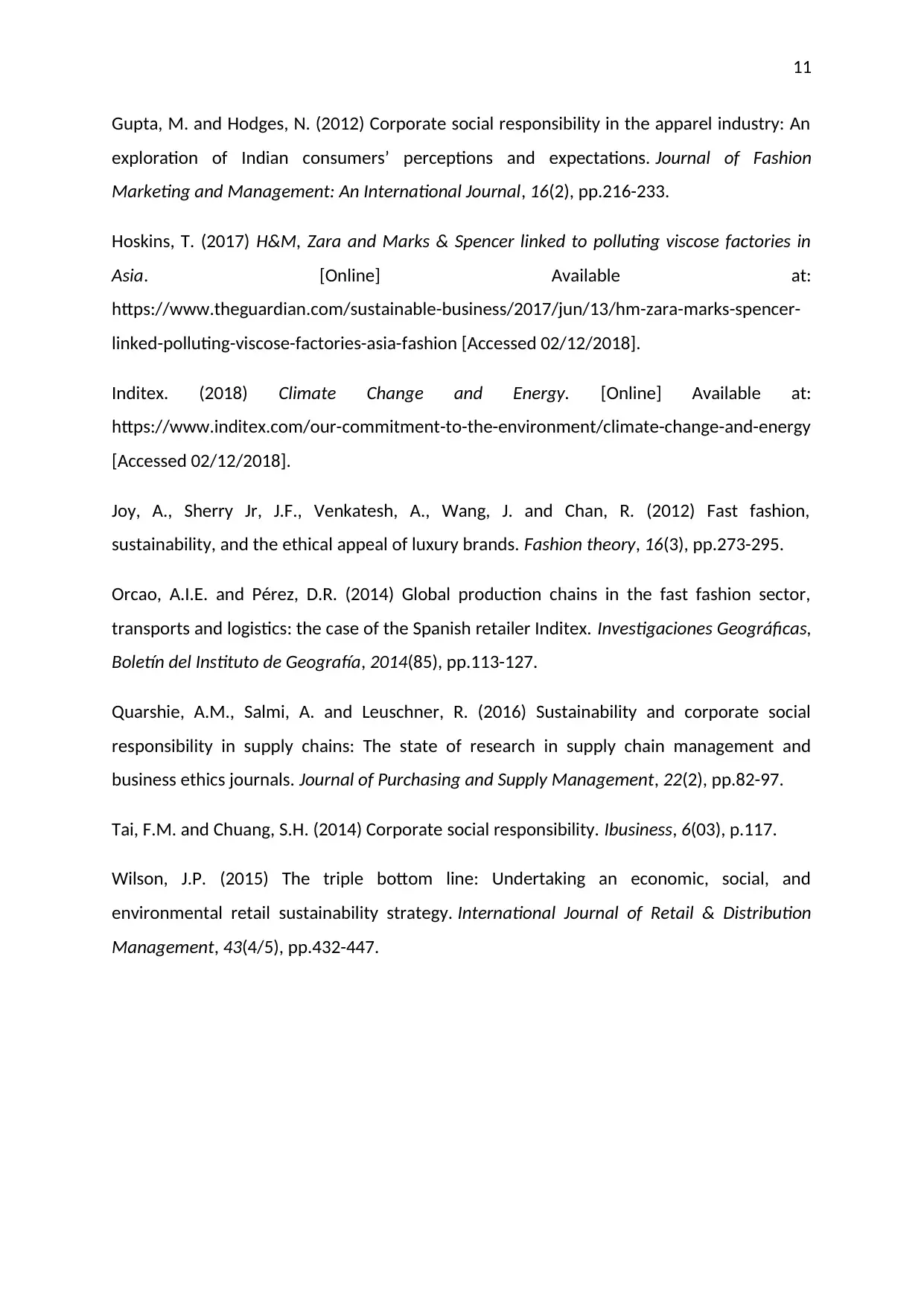
11
Gupta, M. and Hodges, N. (2012) Corporate social responsibility in the apparel industry: An
exploration of Indian consumers’ perceptions and expectations. Journal of Fashion
Marketing and Management: An International Journal, 16(2), pp.216-233.
Hoskins, T. (2017) H&M, Zara and Marks & Spencer linked to polluting viscose factories in
Asia. [Online] Available at:
https://www.theguardian.com/sustainable-business/2017/jun/13/hm-zara-marks-spencer-
linked-polluting-viscose-factories-asia-fashion [Accessed 02/12/2018].
Inditex. (2018) Climate Change and Energy. [Online] Available at:
https://www.inditex.com/our-commitment-to-the-environment/climate-change-and-energy
[Accessed 02/12/2018].
Joy, A., Sherry Jr, J.F., Venkatesh, A., Wang, J. and Chan, R. (2012) Fast fashion,
sustainability, and the ethical appeal of luxury brands. Fashion theory, 16(3), pp.273-295.
Orcao, A.I.E. and Pérez, D.R. (2014) Global production chains in the fast fashion sector,
transports and logistics: the case of the Spanish retailer Inditex. Investigaciones Geográficas,
Boletín del Instituto de Geografía, 2014(85), pp.113-127.
Quarshie, A.M., Salmi, A. and Leuschner, R. (2016) Sustainability and corporate social
responsibility in supply chains: The state of research in supply chain management and
business ethics journals. Journal of Purchasing and Supply Management, 22(2), pp.82-97.
Tai, F.M. and Chuang, S.H. (2014) Corporate social responsibility. Ibusiness, 6(03), p.117.
Wilson, J.P. (2015) The triple bottom line: Undertaking an economic, social, and
environmental retail sustainability strategy. International Journal of Retail & Distribution
Management, 43(4/5), pp.432-447.
Gupta, M. and Hodges, N. (2012) Corporate social responsibility in the apparel industry: An
exploration of Indian consumers’ perceptions and expectations. Journal of Fashion
Marketing and Management: An International Journal, 16(2), pp.216-233.
Hoskins, T. (2017) H&M, Zara and Marks & Spencer linked to polluting viscose factories in
Asia. [Online] Available at:
https://www.theguardian.com/sustainable-business/2017/jun/13/hm-zara-marks-spencer-
linked-polluting-viscose-factories-asia-fashion [Accessed 02/12/2018].
Inditex. (2018) Climate Change and Energy. [Online] Available at:
https://www.inditex.com/our-commitment-to-the-environment/climate-change-and-energy
[Accessed 02/12/2018].
Joy, A., Sherry Jr, J.F., Venkatesh, A., Wang, J. and Chan, R. (2012) Fast fashion,
sustainability, and the ethical appeal of luxury brands. Fashion theory, 16(3), pp.273-295.
Orcao, A.I.E. and Pérez, D.R. (2014) Global production chains in the fast fashion sector,
transports and logistics: the case of the Spanish retailer Inditex. Investigaciones Geográficas,
Boletín del Instituto de Geografía, 2014(85), pp.113-127.
Quarshie, A.M., Salmi, A. and Leuschner, R. (2016) Sustainability and corporate social
responsibility in supply chains: The state of research in supply chain management and
business ethics journals. Journal of Purchasing and Supply Management, 22(2), pp.82-97.
Tai, F.M. and Chuang, S.H. (2014) Corporate social responsibility. Ibusiness, 6(03), p.117.
Wilson, J.P. (2015) The triple bottom line: Undertaking an economic, social, and
environmental retail sustainability strategy. International Journal of Retail & Distribution
Management, 43(4/5), pp.432-447.
⊘ This is a preview!⊘
Do you want full access?
Subscribe today to unlock all pages.

Trusted by 1+ million students worldwide
1 out of 12
Related Documents
Your All-in-One AI-Powered Toolkit for Academic Success.
+13062052269
info@desklib.com
Available 24*7 on WhatsApp / Email
![[object Object]](/_next/static/media/star-bottom.7253800d.svg)
Unlock your academic potential
Copyright © 2020–2026 A2Z Services. All Rights Reserved. Developed and managed by ZUCOL.





